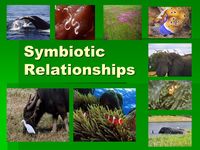
Guess the Symbiotic Relationship
Assessment
•
undefined undefined
•
Biology
•
9th Grade
•
431 plays
•
Medium
Student preview

17 questions
Show answers
1.
Multiple Choice

The hummingbird receives nectar from the flower, and in return the flower is pollinated by the hummingbird.
Mutualism
Commensalism
Parasitism
Predation
2.
Multiple Choice

This Caribbean hermit crab (coenobita clypeatus) uses the shell of a dead snail for protection against its predators.
Mutualism
Commensalism
Parasitism
Predation
3.
Multiple Choice

Bed bugs (Cimex lectularius) are small insects that interact with animals, including humans, and feed on their blood.
Mutualism
Commensalism
Parasitism
Predation
4.
Multiple Choice

The cowbird chick on the left is being fed by the adult sparrow. Cowbirds trick sparrows into caring for their young by removing one of the sparrow’s eggs from its nest and leaving their own in its place.
Mutualism
Commensalism
Parasitism
Predation
5.
Multiple Choice

The golden ground beetle is provided nutrition by the worms that it preys on.
Mutualism
Commensalism
Parasitism
Predation
Explore all questions with a free account
Find a similar activity
Create activity tailored to your needs using
.svg)

Exploring Symbiotic Interactions Quiz
•
9th - 12th Grade

10_Symbiosis
•
9th - 12th Grade

Determine the Relationship: Symbiosis
•
9th - 12th Grade

Symbiotic Relationship
•
9th Grade

Symbiosis Practice Quiz
•
9th - 10th Grade

Symbiotic Relationship
•
9th Grade

Symbiotic Relationship Review
•
9th Grade

Quizizz B.12A: Symbiotic Relationships
•
8th - 10th Grade